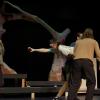December 12, 2011 - 2:14am
The Gathering Place for First Nations and other students at Vancouver Island University is now covered with native grasses and other species.
A crew from Victoria-based Paradise Cityscapes laid a membrane, spread a layer of growing media and planted sedum, fescues and other plants that are well suited to growing conditions on the 3,000-square-foot roof of Shq’apthut: A Gathering Place. Some of the young plants were grown by students in VIU’s Horticultural Technician Foundation Program with others brought in from NATS Nursery, a Lower Mainland firm that specializes in Pacific Northwest Native Plants.
Laura-Jean Kelly, an instructor at VIU’s G.R. Paine Horticulture Centre, said the new roof is a valuable teaching tool for students in the horticultural technician foundation certificate program.
Students who are just completing the one-year program have grown the plant stock throughout their term. They’ve learned about plant selection based on species that can thrive in a five centimetre thick mixture of pumice and compost and survive long spells of hot, dry weather as well as heavy rainfall and cold.
New horticulture students who begin their program in early January will have the opportunity to see the roof mature and learn how to keep it healthy.
“With all the green roofs that are being installed, there’s a need to teach students about their design, benefits and how to maintain them,” said Kelly.
Green roofs are becoming increasingly popular in modern buildings for several environmental reasons. The plant material and soil absorb rainfall and slow down and reduce the runoff that ends up in municipal sewer systems – often after it has collected pollutants along the way. The organic material is also efficient at insulating buildings and reducing consumption of energy to keep the interior warm in winter and cool in summer.
The roof, installed with the help of $25,000 donation from VIU Students’ Union, reflects the university’s commitment to sustainability.
“The green roof is located on a building that is highly visible from the 5th street entrance to the Nanaimo campus and is hoped to further raise awareness of ways that buildings can be designed and landscaped to support a healthy and sustainable environment,” said Craig Hanson, VIU Facilities Planner/Developer.
In addition to improved water retention and energy efficiency, the roof will be used for research into the capacity for green roofs to sequester carbon dioxide, a major greenhouse gas.
Biology professor David Gaumont-Guay will monitor carbon dioxide levels on the Gathering Place roof and other green roofs including VIU’s new Cowichan campus, the Regional District of Nanaimo’s transit facility and the offices of Island West Coast Development, also in Nanaimo.
It is part of a multi-year research project supported by the Canadian Foundation for Innovation and British Columbia Knowledge Development Fund. Gaumont-Guay’s Biometeorology Research Group uses instruments that measure weather conditions and carbon-exchange levels on each of the four roofs and track changes that occur throughout the seasons.
“We want to find out how much green roofs can fix carbon dioxide (CO2) from the atmosphere and put it into the biomass – the plants – or put it into the soil,” said Gaumont-Guay.
Plant material is also effective in reducing the amount of carbon dioxide in the atmosphere. It’s one of the reasons forested areas are so important in mitigating the vast amounts of greenhouse gases that contribute to global warming, said Gaumont-Guay.
He was surprised at the lack of research into the carbon offset potential of green roofs and he sees a real need to measure levels of carbon dioxide on the roofs. “It’s a big unknown and it’s an important question,” he said.
Kelly included a curving line of grasses in her design for the roof to pay tribute to Charles David Keeling a scientist who pioneered research into CO2 levels in the atmosphere starting in the late 1950s.
The curve on the roof symbolizes the rise and fall of CO2 levels throughout the seasons. Keeling’s measurements showed the natural changes throughout the year as plants grow and later decay. The American scientist’s work also showed the overall increase of CO2 levels year after year. His detection of that disturbing trend helped raise awareness about increases in greenhouse gases and the dangers of global warming.
-30-
Websites:
[VIU's 12-month Horticultural Technician Certificate Program (* a few spaces are available for January 2012 intake)]()
[VIU’s Biometeorology Research Group]()
[Paradise Cityscapes]()
[Biography of Charles David Keeling]()
[Photos on Flickr]()
Tags: In the Community






